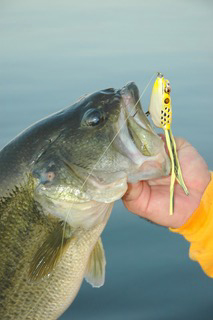
Does this look like lunch to you?
|
Florida’s Fish and Wildlife Commission (FWC) recently passed a ruling that would allow the sale of farm-raised Florida-strain largemouth bass as food statewide.
The ruling has some bassophiles nervous—OK, it put their shorts in a wad--because when you put a price on any wild critter’s head, that critter frequently declines in numbers—capitalism does not limit itself to legal enterprise.
The concern, of course, is that a few shady folks in possession of large gill nets might decide to make some night hauls at Okeechobee to boost their expendable income once selling bass becomes legal.
But I’m thinking that concern may be misdirected in this case.
I mean, have you ever tasted a largemouth bass out of Florida’s mossy, hydrilla-laden waters?
Remember, this is in a state where you can buy fresh swordfish, blackfin tuna and red snapper over the counter in Publix.
So who is going to buy the fillets of Micropterus salmoides?
Wild Florida bass don’t even taste very good compared to the much more edible crappies, bluegills and shellcrackers found in many state waters. Largemouths tend to be a bit fishy and also a bit mossy, at least from the various waters where I’ve (rarely) taken one home to eat.
It’s true that pond-reared bass can be taught to eat commercial floating fish pellets, which contain a good bit of grain as well as protein and other supplements. Presumably a bass raised on this food would have a less fishy taste as well as lack the mossy overtones of many wild bass. You are what you eat, remember
But any that were poached in the wild by outlaw netters would still taste like they had been eating crawfish, frogs, shiners and baby alligators, so any illegal market likely would dry up pretty quickly.
Polluting the Gene Pool?
Perhaps more concerning is the possibility that a strain of domesticated bass developed for pond-rearing as food—that is, fish that readily eat pellet food and convert it very rapidly to large size—might escape into the wild as penned wild creatures have a way of doing.
Domesticated (and gene-altered) Atlantic salmon are escaping on a frequent basis, to the peril of wild stocks along the Pacific Coast where they are farmed.
If some of the Frankenbass got into one of the major lake chains—the Kissimmee or the St. Johns, for example--the genes might quickly spread through the population of dozens of lakes, for better or worse.
True, anglers would no doubt be delighted with bass that grow bigger faster for a time, but there are usually some undesirable traits riding along on the genes of domestic animals returned to the wild.
Essentials like the instinct to avoid predators are not built in to domesticated critters. To say nothing of the possibility of some lethal genetic misdirection that might then spread throughout the wild population. It’s doubtful, but it’s assuredly not impossible, and the impact on Florida’s freshwater fishery could be profound.
True, Florida strain bass have been raised for stocking in the wild for decades, and have been shipped all over the southern half of the U.S. in efforts to grow bigger bass for local anglers. The results have generally been very favorable, with many states setting new records with the Florida transplants as they grow to maturity. But those fish are not engineered to eat Purina and grow into Sumo proportions—they are genetically wild fish.
The Economics of Bass Fritters
It’s all about the Benjamin’s, of course. According to the FWC, farm-raised largemouth bass is valued at around $5.75 per pound, a 90% increase from 2013, but note that this is still cheap compared to the price of wild fish of nearly any other species.
Close to 200 farms in other states reported producing largemouth bass for food in 2018 for a total value of $27 million. The Florida Department of Agriculture and Consumer Services, doing the job it’s appointed to do, wants to get a few Floridians a slice of that business, and has pushed for the bass farming rule.
But it may not be wise in terms of the future of the enormous cash cow the state now enjoys in their largemouth bass sport fishery. Tens of thousands of residents as well as thousands of non-residents chase the state’s special breed of bass, Micropterus salmoides floridanus—the Florida Largemouth—because it grows so fast and gets so big.
And all those bass-heads spend hundreds of millions of dollars in Florida yearly in their pursuit, buying everything from $60,000 bass boats to $5,000 forward-looking and side-scanning sonar—one on the console, one on the bow--to hunt them down. There are even $60 bass lures being hurtled at the fish: I’m looking at you, Triton Mike Bucca.
But nearly all the bass these anglers catch are lovingly handled and quickly released—the vast majority survives multiple catch and release episodes in their 10-year or so lifespan. Very few people eat them.
Bottom line is: a considerable number of bass anglers who are becoming aware of the bass-as-commodity ruling are expressing concern. If it ain’t broke, don’t fix it seems to apply. Especially where we might see a few benefit to the detriment of the many.
Frank Sargeant